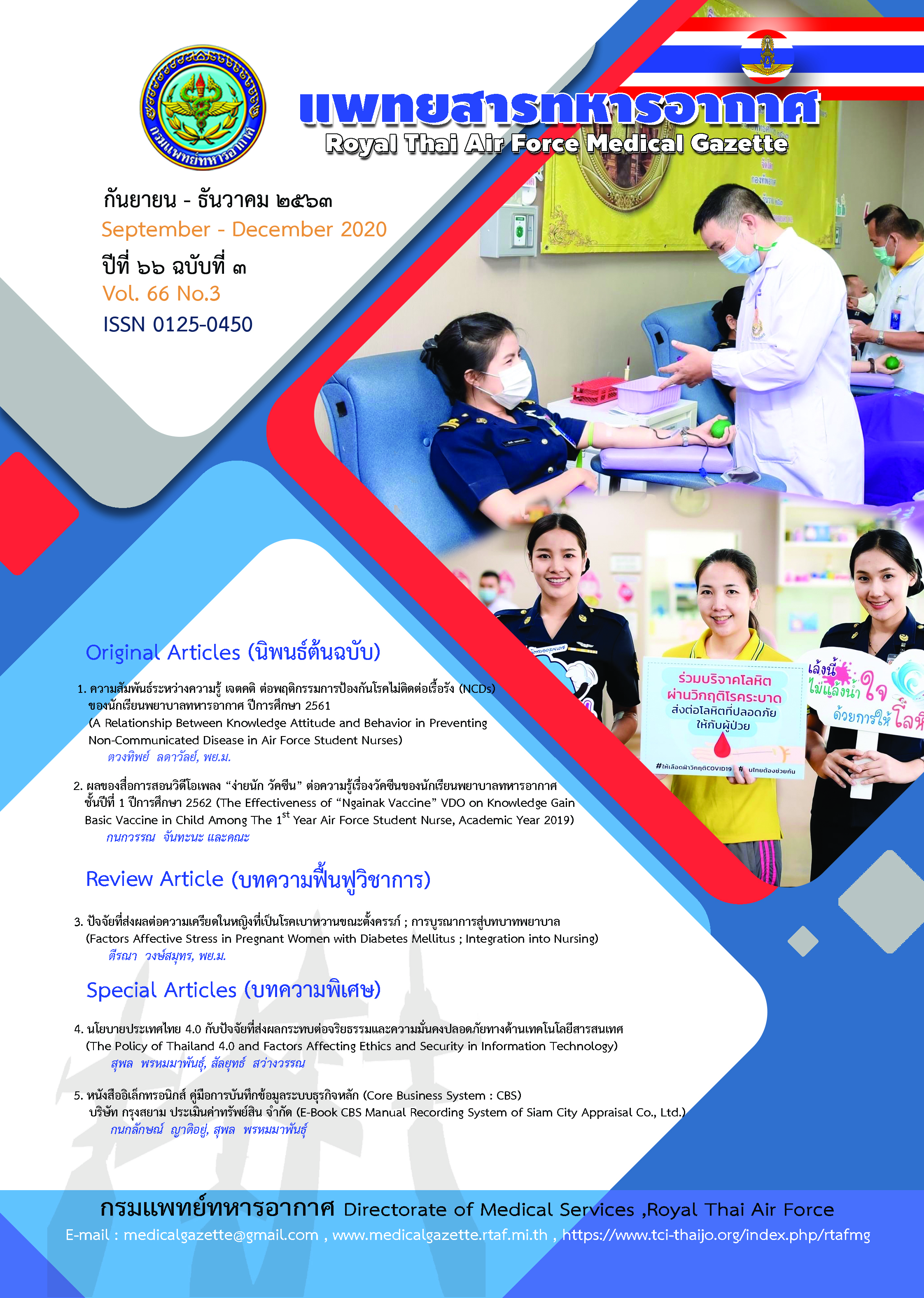A Relationship Between Knowledge Attitude and Behavior in Preventing Non-Communicated Disease in Air Force Student Nurses
Main Article Content
Abstract
This is a descriptive research studying a relationship
between knowledge, attitude and behavior in preventing non-
communicated disease in Air Force Student Nurses by using KAP
model. A sample was 140 Air Force Student Nurses selected by
random sampling. The instrument in this study was a
questionnaire: knowledge Non-Communicated Disease, attitude
and behavior in Preventing Non-Communicated Disease. Data
were analyzed in term of frequency, percentage, means,
Pearson’s product moment correlation coefficient and ANOVA
with a preset of significant level at .05
The result found that 100 % of student’s knowledge at good
level. The highest score is sign and symptom of disease.
Student’s attitude at good level average score is 51.84. The
highest score is attitude in perceiving benefit of preventing Non-
Communicated Disease. Student’s behavior is moderate. An
average score is 19.74. The result of relationship analysis found
that Knowledge Non-Communicated Disease related with attitude.
(r=0.418). Analysis of Variance found that knowledge non-
communicated disease, attitude and different in each year
(F=19.493, df=139, p<.05, F=5.036, df=139, p<.05) and behavior
in preventing non-communicated disease is not different in each
year (F=1.394, df=139, p>.05).
A recommendation of this result is the Royal Thai Air Force
Nursing College should have more health promotion activities to
make students realizing a danger and adapting behavior for
preventing non-communicated disease.
Article Details
บทความที่ได้รับการตีพิมพฺเป็นลิขสิทธิ์ของวารสาร
References
เอช ไอ วี/เอดส์ ของคนประจำเรือไทย* (The KAP Model and A Study of Behavior and Attitude
on Prevention HIV/AIDS Infection in Thai Seafarers). คณะโลจิสติกส์ มหาวิทยาลัยบูรพา. 2556.
2. เบญจมาศ สุขศรีเพ็ง. แบบแผนความเชื่อด้านสุขภาพ (Health Belief Model). ค้นเมื่อ กรกฎาคม 9, 2561,
จาก https://www.gotoknow.org/post/115420. 2556.
3. เบญจมาศ สุขศรีเพ็ง. แบบจำลองการวางแผนส่งเสริมสุขภาพ (PRECEDE - PROCEED Model). ค้นเมื่อ
กรกฎาคม 10, 2561, จาก https://www.gotoknow.org/posts/115416. 2559.
4. แพนนี่ ตรีวิเชียร และจิราพร เกศพิชญวัฒนา. ปัจจัยทำนายพฤติกรรมส่งเสริมสุขภาพของนายทหารนอก-
ราชการ วารสารพยาบาลทหารบก, ปีที่ 11 (ฉบับพิเศษ), หน้า 94-100. 2559.
5. มนรดา แข็งแรง. “ความรู้ ทัศนคติ และพฤติกรรมการปฏิบัติตัวของผู้ป่วยโรคเบาหวานที่มารับบริการใน
โรงพยาบาลชุมชนแห่งหนึ่ง ในจังหวัดอุบลราชธานี.” การประชุมวิชาการ และนำเสนอผลงานวิจัยระดับชาติ
ราชธานีวิชาการ ครั้งที่ 2. 2559.
6. วิภาวรรณ ศิริกังวานกุล, รัตน์ศิริ ทาโต และระพิณ ผลสุข. ปัจจัยทำนายพฤติกรรมป้องกันโรคหลอดเลือด
หัวใจของกำลังพลกองทัพบก วารสารพยาบาลศาสตร์. 2560.
7. สุจิตตรา จันทร์ลอย. ทฤษฎีการเรียนรู้ตามแนวคิดของบลูม. ค้นหาเมื่อ กรกฎาคม 15, 2561. จาก http://
weblogsimple.blogspot.com/2011/08/blog-post 21.html. 2554.
8. สุพัตรา ศรีวณิชชากร. สถานการณ์โรคไม่ติดต่อ ปัจจัยเสี่ยงต่อโรคไม่ติดต่อและการจัดระบบบริการเพื่อ
ตอบสนอง ต่อโรคไม่ติดต่อตามเป้าหมายและตัวชี้วัดระดับโลกของประเทศ ไทย. ค้นเมื่อกรกฎาคม 17, 2561.
จากhttp://k4ds.psu.ac.th/ncd/files/SituationReport_20160419.pdf. 2559.
9. สำนักงานโรคไม่ติดต่อ. แผนยุทธศาสตร์การป้องกันและควบคุมโรคไม่ติดต่อ ระดับชาติ 5 ปี (2560-2564).
ค้นหาเมื่อ กรกฎาคม 7, 2561. จาก http://www.thaincd.com/2016/mission/activity-
detail.php?id=13065&tid=31&gid=1-015-005. 2559.
10. อรรถพงศ์ เพ็ชร์สุวรรณ์. พฤติกรรมของประชาชนเกี่ยวกับโรคความดันโลหิตสูงและโรคเบาหวาน. ค้นเมื่อ
มิถุนายน 29, 2561. จาก http://library1.nida.ac.t/tempaper6/sd/2552/19571.pdf. 2559.
11. อรรถเกียรติ กาญจนพิบูลวงศ์. รายงานสถานการณ์โรค NCDs. พิมพ์ครั้งที่ 1. สำนักงานพัฒนานโยบายสุขภาพ
ระหว่างประเทศ อาคารคลังพัสดุ (ถ.สาธารณสุข 6) กระทรวงสาธารณสุข ถ.ติวานนท์ อ.เมือง จ.นนทบุรี
11000, 2558.


